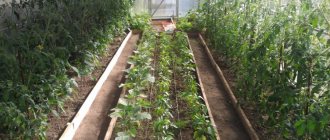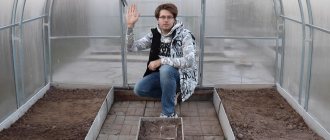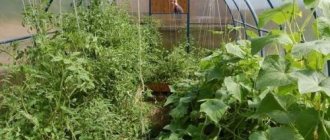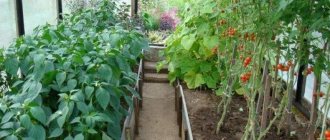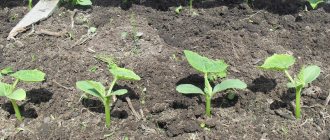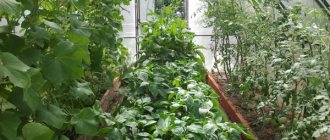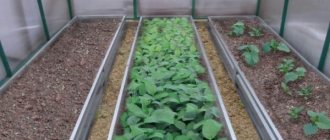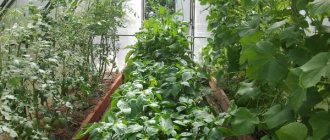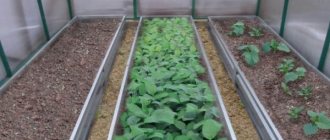Knowing the peculiarities of growing and caring for basic vegetable crops, a gardener can get a healthy and rich harvest. Proper germination of cucumber seeds, the subtleties of using greenhouses for planting seedlings, competent selection of plants - knowledge that will ensure the environmental friendliness and usefulness of the harvest.
Every gardener dreams of growing cucumbers, peppers, eggplants and tomatoes, and onions and beans in his greenhouse. But will all these plants live under one roof?
Placing a greenhouse on the site
In order for the greenhouse to have a lot of sunlight, it should be installed from north to south. So, the greenhouse will be illuminated all day: in the morning the sun will warm the beds that are planted on the eastern side, and in the afternoon - the beds on the western side.
- When installing a greenhouse, you need to take into account the slope of the site, prevailing winds and other nuances.
- If the greenhouse is located from the east to the west, then tall plants should be planted on the north side.
- In this case, low-growing plants are best placed along the southern wall.
Experts do not recommend placing cucumbers and tomatoes in one greenhouse; it is best to install several greenhouses on the site. This is due to the different growing conditions of plants: Tomato bushes like low humidity and good ventilation, while cucumbers like moist, stagnant air.
If it is not possible to install several greenhouses, then you can place cucumbers and nightshade representatives in one, following certain rules so that all plants are comfortable.
Seedlings for winter growing
Some crops are sown directly into the greenhouse, but more often already grown seedlings are planted in it.
Seeds can be sown in containers or small peat pots. The choice of method depends on the type of vegetables.
For example, eggplant seedlings cannot be sown in peat pots; weak plant roots will not be able to penetrate the soil. Cucumbers and peppers do not like being dug up; it is better to sow them in separate cassettes or replant them using the transshipment method.
To get healthy and strong seedlings, the seeds need to be sorted and soaked in a growth stimulator. After this, they are washed and placed in damp gauze for pecking. When planting, it is important to monitor the degree of depth; usually it does not exceed 1-2 cm.
Boxes or containers with pots are covered with glass and exposed to bright light. The optimal temperature for germination depends on the crop. For example, eggplants and tomatoes need moderate heat, while cucumbers and peppers need a temperature of at least 25°C .
Seedlings are fertilized after the formation of 3 true leaves. It is best to use diluted organic matter or superphosphate.
When the seedlings grow, picking will be required.
Tomatoes and peppers must be pinched to stimulate bud formation.
Arrangement of beds in the greenhouse
The beds are divided based on the width of the greenhouse. Most often these are two or three beds. If the width of the structure is six meters, then it is best to make several half-meter passes between the beds.
- You will get one bed along each wall and one bed in the middle.
- This arrangement makes it easier to care for plants.
- The door is located at the end of the structure, which promotes excellent air circulation during ventilation.
- The middle bed is ideal for growing tomatoes.
Greens will grow beautifully under tomato bushes. In addition, the specific smell of greenery repels pests.
For cucumbers, it is best to select a bed with the least amount of light. Cucumbers love shade and moisture. Peppers and eggplants, which love light, are best planted on the south side.
Self-construction of a polycarbonate greenhouse
A polycarbonate greenhouse can be placed on a strip foundation. To do this, dig a trench of the required size with a depth of about 70 cm. Then lay out its bottom with a sand cushion, each layer of which (20-25 cm) is watered and compacted. You will need several of these layers.
Next, reinforcement is performed to give rigidity and formwork is installed from wooden boards, which should rise 20-30 cm above the surface. Then a concrete mixture is prepared (cement, sand, crushed stone and water) and poured into the formwork.
Next, the frame is erected. For this you can use wooden beams or metal pipes. The frame is covered with polycarbonate. Self-tapping screws with thermal washers are used as fastenings. It is important to place polycarbonate sheets with the protective layer facing outward.
Season for planting seedlings in a greenhouse
Seedlings must be planted at a soil temperature of + 15 degrees at a depth of fifteen centimeters. Heat-loving plants should not be planted in cold soil, otherwise they will take a long time to get sick and take root.
The development of the root system directly depends on soil temperature.
- The best age for planting seedlings in a greenhouse is from forty-five to sixty-five days, the distance between the bushes should be at least forty-five centimeters.
- Tomato bushes are able to send out additional root shoots, which allow them to obtain more nutrients from the soil. Accordingly, under favorable conditions, the yield of tomatoes will be much higher.
When planting a bush in a hole, do not completely cover it with soil, sprinkling it with soil one centimeter above the root system. Ten days later, when the bush has taken root, it is added three centimeters.
Official registration of business
You need to understand that when you start selling vegetables on an industrial scale, you become a real businessman, therefore, you are obliged in the eyes of the law to undergo state registration, especially if you intend to work as a supplier of corporate networks, since they do not work with illegal immigrants.
In addition, you need to obtain an official name in order to obtain official documents confirming the quality of your products.
For the industrial cultivation of vegetables for the purpose of their subsequent sale, it is necessary to officially register the business
Thus, the forms of ownership for vegetable farms can be as follows.
1. Personal subsidiary plot, in which the area on which you can work should not exceed 2.5 hectares. In addition, you will also be restricted from using third party labor under your employment agreement. In other words, only you and your family members will be able to work in greenhouses.
As for official registration, in this case it will be enough for you to receive a document confirming the ownership of a specific land plot.
2. Peasant farming. Unlike private household plots, in this case the entrepreneur’s law does not limit:
- opportunities to hire workers;
- ownership of the area occupied by the business;
- annual turnover.
The owner of a peasant farm is obliged to register as an entrepreneur through a tax registration order, which implies that he will subsequently transfer a certain percentage - tax - to the state.
The difference between individual entrepreneur and LLC
3. An individual entrepreneur or a limited liability company are forms of organization that also do not have similar restrictions for private household plots, therefore, if you intend to work “largely,” it is best to become an individual entrepreneur, subject to sole ownership of the enterprise, or an LLC, if there are several owners .
In the second case, the authorized capital of the organization must, according to the law, be at least 10 thousand rubles.
A vegetable grower who intends to sell greenhouse-grown fruits must choose to work under a specific taxation system, provided that he is registered as:
- peasant farm;
- OOO;
- IP.
For the line of activity we are considering, this system will be the Unified Agricultural Tax, which implies the payment of a fixed percentage of the profit received.
Vegetable neighborhood rules
The most popular greenhouse plants are cucumbers and tomatoes. Therefore, they are planted first, followed by other crops. Plants to be planted should be low-growing.
You can grow radishes in early spring and plant your main vegetables after harvest.
- Tomatoes go well with herbs, beans, cabbage, and bell peppers.
- Cucumbers go well with zucchini, herbs, garlic, onions, and beets.
- Cabbage grows well next to carrots, radishes, onions, herbs, and spinach.
- In early spring, crops that grow and ripen quickly can be planted, then early ripening ones can be planted, and cold-resistant varieties can be planted in late summer.
To ensure that the greenhouse intended for growing tomatoes does not stand idle in early spring, you can plant cold-resistant vegetables: lettuces, radishes, onions, herbs.
You should choose large, undamaged seeds. Seeds should be placed in the holes at a distance of one centimeter from each other. After sowing radishes, the bed must be covered with film.
How to start your own greenhouse business so as not to get into trouble and not go into the red
Have you decided to turn your favorite hobby into a business and start growing cucumbers and tomatoes for sale? An excellent and very profitable idea! But only on the condition that you build the right greenhouse, purchase the right seeds and take into account many other nuances.
An expert shares with readers of Ogorod.ru how a novice farmer can understand all the intricacies of industrially growing vegetables in a greenhouse and all the pitfalls of this difficult task.
Vladislav Shabanov is an agronomist with 20 years of experience, the head of a greenhouse complex at one of the largest agricultural enterprises in Belarus.
Starting your own business is never easy, especially if you have absolutely no experience. But if you approach the issue seriously, take into account all the nuances and calculate all the risks, the first experience will not be sad.
Vladislav, let's start with the main question: what is more profitable for a private owner to grow for sale - cucumbers or tomatoes?
There is no clear answer to this question. Each culture has its own disadvantages and its significant advantages. Tomatoes, for example, give more gross output (in one revolution from 1 sq.m. you can harvest up to 25 kg of tomatoes and up to 14-16 kg of cucumbers). Plus, at the beginning of the season, the purchase price for tomatoes is higher, and the harvested crop is stored longer. If you didn’t sell something today, the fruits can easily lie for up to 14 days. Cucumbers are a perishable commodity that quickly withers, but they begin to bear fruit earlier than tomatoes. If you do not have a refrigeration unit, you can keep the crop in marketable form for a maximum of 2 days. Then the fruits lose turgor, begin to turn yellow, etc.
But, on the other hand, cucumbers can be picked early in the morning and immediately taken to the market. In order not to slow down the growth of the next bunches, you will have to pick the tomatoes when they are barely pink, then let them sit for several days until they turn red and only then sell them.
As you can see, the choice is not at all obvious. And, in principle, you can try to grow both one and another crop - the greenhouses and equipment for them will still be the same.
In its homeland, the tomato is a perennial plant. Is it possible for a farmer to take advantage of this feature and grow bushes for, say, 2-3 years? Will this be beneficial?
In the middle zone this is economically unjustified. In winter, plants require additional lighting with special sodium lamps with a power of 400 to 700 W. But natural solar activity, of course, is much greater than any, even the most powerful lamp. Therefore, the harvest in winter is much lower, and the costs of growing it are very high.
In addition to the huge electricity bill, you will also need to add heating costs
It will also be unprofitable to use a greenhouse for one rotation of plants. If selling grown products is your main income, I recommend making two turnovers per season: spring-summer and summer-autumn. For the first rotation, tomato seeds will need to be sown in mid-February, and cucumber seeds at the end of February. For the second rotation: tomato seeds - in mid-June and cucumber seeds - in early July.
Moreover, you can grow one crop or alternate them:
- first and second turns – cucumbers;
- the first turn is cucumbers, the second is tomatoes;
- the first and second turns are tomatoes.
What growing technology would you recommend to a beginner?
This, again, is a matter of preferences and capabilities of each individual farmer. Those who have limited funds often choose soil. This technology will cost the least, because... you will not need to purchase mats and install an expensive drip irrigation system. However, it is unlikely that it will be possible to obtain a very high yield on the soil.
Growing using low-volume technology (in mats with mineral wool or an organic substrate - high-moor peat or coconut substrate), despite all its complexity and cost, has obvious advantages. Firstly, this is a significant increase in yield. Secondly, cleanliness and order in the greenhouse.
The farmers I consulted started by growing cucumbers in the ground. They harvested 5-6 kg of crops per 1 sq.m. and had a constant headache - where to put the waste soil and where to get good soil for planting new seedlings. When they finally decided to switch to low-volume technology, the problem of disposing of several tons of land immediately disappeared, and the cucumber yield increased to 14 kg per 1 sq.m.
What does low-volume growing technology mean - is it the same as hydroponics?
Not really. Hydroponics is the growing of plants in mineral wool cubes in such a way that their entire root system is in water (nutrient solution). Low-volume growing technology means that the roots of plants are not in water, but in a substrate (mineral or organic) in a small volume.
Growing tomatoes and cucumbers in hydroponics or using low-volume technology does not accept any amateur activity. Here you need to adhere very strictly to technology and follow the advice of experts. Plants need to be watered regularly (3 times a day), doses and compositions of fertilizers specially selected and calculated for your specific conditions are applied, tying, pinching, pinching and harvesting are carried out in a timely manner, the required temperature and humidity are maintained, etc. Failure to fulfill or untimely fulfillment of at least one point entails loss of harvest and, as a consequence, huge losses.
If we compare mineral wool and coconut substrate - which is better?
In terms of yield, both substrates are practically the same. But the price for them confuses many farmers. A good coconut substrate costs almost 2 times more than mineral wool.
It turns out that mineral wool is more profitable. But this is only at first glance. Mineral wool, for example, can only be used for 1 year, while coconut substrate lasts for 4 years. Moreover, the productivity of the latter will remain at a high level throughout this time:
- 1st year of using coconut substrate - the yield is the same as when grown on mineral wool;
- 2nd year of use – the yield is higher than with mineral wool;
- 3rd year of use - the yield is lower than in the second year, but higher than in the first;
- 4th year of use - the yield is the same as in the first year.
Another point is recycling. Essentially, mineral wool is basalt (volcanic rock). There is nothing so terrible about it; it can be processed in special factories. Abroad, waste mineral wool is used as a component of asphalt concrete pavements. We don't have such technologies yet. Greenhouse plants simply store tons of waste substrate, not knowing what to do with it next, because... It costs a lot of money to take it to a landfill. Spent coconut substrate is a valuable organic fertilizer containing all the nutrients plants need. After use, we simply scatter it on the field, and dispose of the plastic bags in which it was packed as regular recyclables.
If we compare manure with spent coconut substrate, then 10 kg of the latter in nutritional value is equal to approximately 1 ton of manure.
Now many different companies have begun to appear on the market that offer coconut substrate at a lower price. You shouldn’t blindly rush into such offers, because... Often the packages contain a low-quality product. As our experiments have shown, the best coconut substrate is the one that has a three-layer structure (the bottom layer is “chips,” the middle layer is medium-sized coconut fiber, the top layer is shredded coconut fiber). In such conditions, roots grow best and plants produce the greatest yield.
Many traditionally believe that cucumbers and tomatoes grown in small quantities are dummies, which contain very few vitamins and minerals and, on top of that, nitrates are off the charts. But the ground ones, which were fed exclusively with organic matter, are a completely different matter, completely beneficial... What can you say about this?
In greenhouse plants, the dose of fertilizers is clearly regulated by agronomists and special programs, i.e. The plant does not receive more than what is objectively needed for normal growth and development. Firstly, because an excess of minerals (especially nitrogen) leads to an increase in the nitrate content in fruits, which is why the products will not be able to pass sanitary control. Secondly, because on the scale of greenhouse farming, even a slight excess of the dose of fertilizer results in large additional costs.
By the way, domestic greenhouse plants carry out tests for the content of nitrates, radionuclides and pesticides in specialized state laboratories every 10 days.
Also, once a year, products are checked for the content of harmful substances and heavy minerals (more often this is not required, since if the growing technology is followed, they are absent from the fruits)
And those gardeners who grow cucumbers and tomatoes in the ground should remember that nitrogen (excess of which leads to the accumulation of nitrates in fruits) is a very mobile element that is easily absorbed by plants and is constantly renewed in the soil thanks to microorganisms. Even when growing vegetables without the use of chemical fertilizers, spraying and feeding them with organic matter and all kinds of infusions and decoctions, you cannot be sure that you are getting an environmentally friendly harvest, free of nitrates, because Nitrogen is found in any organic matter and it is very easy to overdo it. Any summer resident who generously fertilizes his beds with manure and compost will have nitrates in his produce going through the roof.
What varieties/hybrids would you recommend a novice farmer choose?
In greenhouse farms (it doesn’t matter whether cucumber or tomato) varieties are not grown at all. And that's why:
- they are very unstable (some bushes can produce a good harvest, while others can produce very little);
- the fruits on the bushes of varietal plants are heterogeneous in shape and size (which means there will be a lot of substandard);
- varieties are less resistant to unfavorable conditions and more susceptible to diseases than hybrids.
The varieties can be planted by private owners for their own needs, to be eaten from the bush and rolled up. For those who grow cucumbers and tomatoes for sale, I advise you to choose exclusively modern, highly productive hybrids.
When choosing a hybrid for your greenhouse, talk to colleagues in your area, ask what they grow, try the crop if possible, talk to experts. Select and plant several items. Under no circumstances should you start a business by growing just one hybrid! If something goes wrong (it turns out to be too capricious, low-yielding, tasteless, the plant does not like your conditions, etc.), you will lose the whole season. First, I advise you to try to grow several different hybrids, see how they behave, what kind of harvest they will produce, how much their fruits will appeal to customers, and only then settle on some options.
If you can afford to build expensive high greenhouses, you have a large family, all members of which are ready to get involved in the work and immerse themselves in mastering the intricacies of greenhouse farming, choose foreign hybrids (Dutch, German, Polish, etc.). Despite their demanding growing conditions and the high cost of seeds, you can get the largest amount of production from such plants. If you have a low greenhouse and you are going to grow crops in the ground, it is better to opt for domestic hybrids. They are less demanding on growing conditions and will forgive you certain mistakes in agricultural technology, but, however, they will also produce a smaller harvest.
For those who are planning to grow cucumbers , I recommend choosing parthenocarpic hybrids that do not require pollination. They always produce consistently high yields and have a low percentage of non-standard products (usually no more than 5% of the total harvest).
For those who are just starting to grow tomatoes , I advise you to first practice on determinate hybrids, which grow on their own. They are less demanding in care and yield faster (70-80 days after germination). There are also semi-determinate hybrids, but they need to be formed correctly, otherwise they may end up at the knee level. The optimal height for such tomatoes is at the chest level of a person of average height.
To obtain a good harvest of tomatoes in a greenhouse, pollinating insects are needed.
Bumblebees perform the role of pollinators best. For a greenhouse with an area of 20-25 acres you will need 2 hives. The first is placed at the beginning of flowering of the lowest cluster, the second - after 4 weeks.
One bumblebee hive will cost you approximately 65 euros
Over the years of work, in our greenhouses we have tested many different hybrids of domestic and foreign selection in variety trials. For our growing technology (in small volumes on an organic substrate), the Dutch hybrids turned out to be the best in terms of yield, taste and keeping quality. Although I repeat, it is not easy to grow them, and greenhouses for these plants need high, at least 4.5 m at the ridge.
By the way, about the greenhouse: what should it be like?
For a working family consisting of three to four adults, the best option would be a greenhouse with an area of 20-25 acres. This is an area that can be physically handled and made a good profit. But you need to be prepared for the fact that you will have to work hard all season – from early morning until late evening.
On the sides in its lowest part, the greenhouse should be at least 2.2 m high, and better - 2.3-2.4 m, at the ridge - 4-4.5 m. This allows you to create an optimal angle of inclination of the roof, so that in winter from the snow load did not tear the film or, even worse, did not collapse the entire structure.
It is not necessary to install a very long greenhouse. A 40-meter length is quite enough. And the optimal width is 11 m. I’ll explain why. If you make rows across the greenhouse, in the middle you will have a passage 1 m wide (this is the technological area where you will walk, place boxes with the harvest, etc.), and to the right or left of it there will be rows 10 m wide every. This will make it easy for you to lay the mats without having to cut anything. Also, in such a greenhouse the optimal proportions of the height of the roof and walls will be observed, which will minimize the snow load.
A width of 12 m is already the ceiling. It is not worth making it wider for a given roof height, otherwise in winter your greenhouse may simply collapse under the weight of snow, or you will have to spend a lot on additional rafters, which will significantly increase the cost of construction.
In the middle zone, the rows of plantings should be directed from north to south - with this arrangement, the sun illuminates all parts of the plants during the day, and they do not shade each other. And how to install a greenhouse is a matter for the owner. Build it from north to south - place the rows in the same direction, build from west to east - make short rows across the greenhouse. It doesn’t matter how the greenhouse is built, the most important thing is how the rows of plants will be arranged in it.
Many summer residents and novice farmers think that the more plants, the better - the larger the harvest per 1 sq.m. they can harvest. No! It has long been calculated and proven that the optimal amount, in terms of comfort for plants, their health and the amount of harvest collected from them, is 2.5 (maximum 3) plants per 1 sq.m. If, say, you have a greenhouse with an area of 20 acres, a maximum of 6,000 bushes should be planted in it.
Polycarbonate, glass or film – which coating should you prefer?
The best covering for greenhouses is still glass. It transmits sunlight better than polycarbonate and film, which is very important in the middle zone. But this material breaks easily, is expensive and very bulky, which will entail additional costs for strengthening the greenhouse frame. This option is not suitable for everyone. As an alternative, I can recommend stretching a multi-year light-stabilized film over the roof (it has a yellowish or green-blue tint), and finishing the side walls and ends with polycarbonate. Moreover, it is not necessary to buy thick sheets; you can get by with “five” and even “four”.
And don't forget about the windows. They must be in the greenhouse. Place them at the ends near the roof and on the sides in a checkerboard pattern.
What is better – one large greenhouse or two smaller ones?
Better - one large room, divided into two functional areas: the greenhouse itself, in which crops are grown, and a small utility room for growing seedlings. This room (breeding ground) must be equipped with lamps for supplementary lighting (we, for example, use high-pressure sodium lamps with a power of 600 W) and heating equipment.
To properly install the lamps, you need to get a lux meter. To grow seedlings, the illumination at any point where the plants will be located must be at least 8000 Lux, i.e. lamps should be located so that there are no unlit areas. Moreover, you need to measure lighting at night and preferably under heavy cloud cover. This is done simply: turn on all the lamps and start moving them back and forth, measuring the level of illumination with a lux meter.
If the lighting in the greenhouse is insufficient, the plants will stretch out and grow weakened, which is why they will not be able to produce a high yield in the future.
It is also necessary that the nursery always has a constant temperature. Even at the stage of building a greenhouse, be sure to think about what and how you will heat it.
What about heat guns and fan heaters? Or is it better to use the proven old-fashioned method – a potbelly stove?
Heat guns are expensive. It is better not to use them at all, because... they burn a lot of oxygen. If there are people in the greenhouse while the devices are operating, they may simply get burned. Fan heaters are the same, they burn oxygen and consume a lot of electricity. Water heating is also very expensive.
Stove heating is the best and most budget option. If finances allow, it is best to install a gas or solid fuel boiler. Well, if not, install a stove-stove. This is the cheapest, but also the most labor-intensive option, because... The firewood in it burns out very quickly, and you will have to add it every 1.5-2 hours if it’s -10-20°C outside.
To heat 6 acres, you will need 5 such stoves, welded from 200-liter metal barrels, each of which must have its own chimney. It is best to place the stoves in the center of the greenhouse, right under the ridge. It is better to make chimneys “lying”; first they are directed along the walls and only then taken outside - this way the greenhouse will warm up better. But be prepared for the fact that you will need a lot of firewood. A farmer I know uses about 500 cubic meters of firewood for a greenhouse with an area of about 30 acres during the winter-spring period.
Be sure to provide a place to store firewood near the greenhouse
In addition to stoves, it is advisable to also acquire fans that will disperse warm air throughout the room. And don't forget to buy several thermometers to monitor the temperature in the greenhouse. They will need to be hung in the coldest places.
Another important point that should not be forgotten when building a greenhouse is the irrigation system. Is it possible to save money on it and get by with the most budget option?
If you are going to grow cucumbers or tomatoes in the ground, you can get by with even the simplest belt systems. But for low-volume technology, a “real” drip irrigation system is already required, which is not cheap. To give you an idea, 1 complete dripper will cost about $1, not to mention the fact that you will also need to purchase a 16 mm hose, filters, pumps, cubic water storage tanks, etc.
The most expensive thing about starting a greenhouse business specializing in small volumes is installing an irrigation system. Therefore, it is better not to engage in amateur activities, but to turn to professionals
A properly designed and installed system should deliver the same amount of liquid to each plant no matter how close or far from the main hose it is. The condition of the plants and the amount of harvest they can produce directly depends on this.
Remember the rule: for normal growth and fruiting, the soil (substrate) in the root zone should always be slightly moist. As soon as the soil dries out, the plant experiences stress.
And one more important point that beginners often miss: when watering plants, huge volumes of water are consumed. To make it clear: in a greenhouse with an area of 25 acres, on days with peak solar activity, 12 tons of water are consumed per day. If you pay for such volumes of water at the meter, then you will simply go down the drain. My advice: drill a well.
What other nuances should a novice farmer take into account?
Everything that we talked about above and what will be discussed in the following articles will not make sense if you do not take care in advance about how you will sell the crop. After all, growing and harvesting is only half the battle; it is important to think about to whom, where and for how much you will sell it.
Selling grown products in bulk to resellers is very cheap and unprofitable. The best option is to take care of a place on the market and hire a seller who will give away the proceeds daily. You can also take your products to stores - they usually offer a more or less reasonable price. Small private shops do not take a lot of products, but, as a rule, pay immediately, while large chain stores usually take large quantities, but you can wait several months for your money.
You also need to think in advance about what you will use to deliver and where you will store the goods. With a successful choice of hybrids and following the technology, 1 ton of crop can be harvested per day from a greenhouse of 25 acres. Where to put such a quantity of products? Obviously, you won’t be able to stuff all this into the trunk of your sedan or even a station wagon. At a minimum, you will have to get a small trailer with an awning.
You also need to equip some kind of cool room for storing the ripening/unsold crop - a barn, garage, etc.
In addition, do not forget to test the water for the content of mineral salts (and when growing in small volumes, also for carbonates). When growing in the ground, you will also need to analyze the soil for the main nutrients (nitrogen, phosphorus, potassium, calcium, magnesium). All this is necessary in order to calculate the required dose of fertilizers, thanks to which the plants will develop correctly, but nitrates and other elements hazardous to health will not accumulate in the fruits. Fertilizer doses are calculated in millimoles (mmol). And if you are not fluent in molecular chemistry, then it is better to seek help from a specialist.
As you can see, the desire to become a farmer and the availability of start-up capital are not always enough. To ensure that your dreams of a big harvest and growing profits do not remain just dreams, you need to think through everything carefully and listen to the advice of experts.
The editors of Ogorod.ru would like to thank Vladislav Shabanov for his assistance in preparing the material. And we advise everyone who is interested in the topic of growing cucumbers and tomatoes for sale to follow our publications on the website. Ahead of you is a lot of useful information about growing seedlings, technologies for growing cucumbers and tomatoes in soil and in small volumes, tips on pinching and pinching plants, ways to combat diseases and pests in greenhouses without the use of “chemicals”.
Greenhouse lighting
Vegetable crops should not be deprived of natural light, so as not to spoil the taste of the vegetables. Lamps in vegetable greenhouses should be installed with a different color spectrum, since different rays have different effects on plants:
- Blue rays promote photosynthesis;
- Yellow and green rays contribute to changes in the thickness of plant stems;
- Orange and red rays have a beneficial effect on the flowering process;
- Ultraviolet light hardens plants, making them cold-resistant.
Crops for year-round cultivation
Any crop can be grown in winter. The most popular and productive include:
- cucumbers;
- tomatoes;
- bell pepper;
- zucchini;
- eggplant;
- radish;
- cabbage;
- greens (lettuce, parsley, parsley, celery).
The main thing is to remember that different cultures have different requirements, so do not forget to combine them wisely. For example, cucumbers prefer a humid and hot atmosphere, and tomatoes prefer frequent ventilation and moderate humidity within 60%.
When choosing seeds, give preference to hybrids for indoor ground because:
- they have a shorter growing season;
- do not require pollination by insects;
- They are characterized by high productivity, strong immunity and increased resistance to pests and diseases.
Air temperature in the greenhouse
The air temperature in greenhouse structures may vary. As a rule, the air in the center is better heated than in the corners. Temperatures vary between day and night because the air outside the greenhouse is colder at night.
The temperature in the greenhouse can be adjusted using thermostats:
- Mechanical. The device allows you to adjust the temperature inside the greenhouse;
- Electronic. Such devices with precise settings allow you to set the temperature as accurately as possible;
- Sensory. The programmable device will monitor air and ground temperatures around the clock.
There are homemade thermostats. For example, a water one, consisting of several cans filled with water.
cucumbers
Work on growing cucumbers in a polycarbonate greenhouse traditionally begins with disinfecting the room and preparing the soil for planting. Borrowing soil from a neighboring plot or leaving the soil on which the greenhouse is located without any special changes is not the best way out. Especially if you plan to grow cucumbers for sale.
Plant garter done in a similar way is important.
Soil for greenhouse cucumbers
The main requirements that soil intended for cucumbers must meet:
- have a high fertility rate;
- absorbs moisture well and allows air to pass through;
- be practically neutral (maximum acidity is 6.5).
For cucumbers grown in greenhouse conditions, the most delicious soil is turf soil. Mixed with fresh humus (2 buckets of manure humus per 1 square meter or 4 buckets of leaf humus per the same area is enough), it will not only increase the nutritional value of the soil, but also fluff it up.
Another option is a substrate formed by peat, sawdust from coniferous trees, field soil and humus. The proportions of components in the substrate are the same. Additionally, the soil is enriched with superphosphate, potassium sulfate and ammonium nitrate.
In addition to its main purpose, soil prepared for growing cucumbers in a polycarbonate greenhouse can serve as an additional source of heat. The secrets of thrifty owners lie in the use of ordinary manure. Manure is poured in a layer under the main soil. The resulting fermentation products provide additional heating of the soil. This natural heating method is good if you cultivate cucumbers all year round. A winter greenhouse requires a lot of energy to maintain the temperature required for vegetables. The cost of the harvest is too high. So ordinary manure is a good opportunity to save money.
Soil disinfection
Experienced gardeners do not begin growing cucumbers in a greenhouse without first digging up the soil and disinfecting it. The disinfectant composition is prepared from copper sulfate. Solution concentration – 7%.
You can also use bleach, although its use inside a greenhouse is associated with a number of consequences such as irritation of the skin and respiratory tract, and a high probability of fire upon contact with organic substances.
The premises should not be used for growing vegetables all year round. To reduce the negative impact, soil disinfection in the greenhouse is carried out only in the fall. If you add lime to the soil in the spring, plant growth will be inhibited. Bleach is incorporated into the soil (maximum soil layer thickness 20 cm) using a rake. The required amount is 200 g per 1 square meter of bed.
When working with fertilizers, do not forget about personal safety
Variety selection
The agricultural technology for growing cucumbers in a greenhouse differs from that in open ground. Most varieties cannot be grown in greenhouse conditions. So that the efforts made are not in vain, you will need cucumbers specially bred for a polycarbonate greenhouse or other structures of the same type. It is necessary to choose a suitable variety of cucumbers based on the following parameters:
- Climate. If growing greenhouse cucumbers is started as a business, cold-resistant varieties are most suitable for a region with a harsh climate.
- Pollination, pinching, pruning. The technology for growing cucumbers in a greenhouse involves manual pollination of some varieties with large fruits. If you don’t want to play the role of a bee, you can purchase seeds of self-pollinating varieties. Some hybrids also do without mandatory pruning and pinching.
- Undemanding to lighting. A good harvest is produced by shade-tolerant varieties with long fruits, intended for early planting with extended fruiting.
Growing cucumber seedlings and sowing seeds
Planting cucumbers is done in two ways. The first method is seedlings, the second is by seeds, directly into the prepared soil. Seedlings are used if you want to get a harvest of early cucumbers.
To obtain cucumber seedlings, use boxes filled with soil mixture or special pots. Pots with a diameter of 8 cm made of peat-humus or humus-earth mixture are suitable. Two seeds are sown in each of them. Sowing time - at least a month before planting in the main soil. You can replant ready-made cucumber seedlings for the greenhouse directly in pots, deepening them into the soil 8 cm below the top edge. Moving cucumber seedlings grown in boxes is done carefully, keeping a lump of earth on the roots.
Cucumber seedlings ready for planting in greenhouse soil
The second method does not require additional transplantation efforts. However, crops require a certain temperature regime:
- Before sprouts appear, the required temperature is from 25 to 28°C.
- Early shoots are kept at temperatures from 20 to 22°C during the day and 17°C at night.
- Five-day-old seedlings need a night temperature of no higher than 20 degrees.
Soaking the seeds for 12 hours helps speed up the ripening of fruits. But if the soil is not warm enough, there will be no seedlings. The seeds will begin to rot.
Further care for cucumbers in a polycarbonate greenhouse consists of regularly loosening the beds between the rows, watering, exterminating pests, treating and timely fertilizing the plantings.
Growing tomatoes in a greenhouse
To grow tomato seedlings, you need to plant the seeds in containers. It is best to plant seeds in eraser containers using purchased soil, which can be very easily removed from the container and planted in the ground.
After the seedlings are planted in the ground, they should be watered generously and mulched with grass so that the soil retains moisture for as long as possible.
- Tomato seedlings should be watered regularly, but not overwatered, so that the root system does not begin to rot.
- Tomatoes need to be fertilized at least three times in one season.
- The first time is about a few weeks after the seedlings are planted in the ground.
- These plants especially need phosphorus. You can fertilize yourself by pouring a tablespoon of superphosphate into a bucket of water.
The mixture should be infused for 24 hours. Add bird droppings to the fertilizer. About a liter of fertilizer should be poured under each bush. Tomatoes are fed a second time after the second cluster blooms, and a third time after flowers appear on the third cluster.
Landing rules
To grow vegetables and herbs in a greenhouse, you need to prepare planting material and soil.
The soil is prepared in the fall, the fertilizers necessary for future plantings are introduced into it; if you plan to plant cucumbers, then humus, lime, manure are introduced into the soil; if tomatoes, then potassium chloride and potassium sulfate. For peppers, a solution of water with bird droppings and nitrogen-containing fertilizers are needed, and for eggplants, magnesium and peat.
Vegetable seeds for the greenhouse should be selected from varieties and hybrids intended for protected soil. They need to be inspected, the spoiled ones removed, then the rest of the seeds are placed in a glass, add a small amount of salt, add water and stir.
Some will float, which means the seed is not mature enough to produce a healthy sprout and should be removed, while the remaining seeds should be washed and dried.
It is also necessary to perform etching, that is, disinfection. The easiest way to do this is with water: the seeds are treated with water for fifteen minutes, alternating hot with cold.
And then, to speed up germination, they use the stratification method - the seeds must be soaked in water and kept in a warm room until completely swollen. Next, they are mixed with wet sand, poured into shallow containers and sent to a refrigerator with a temperature of zero to five degrees, and kept for thirty to one hundred and twenty days.
Before planting plants in their garden plot, many gardeners germinate seeds at home, that is, prepare seedlings. You can buy soil for seedlings or prepare it yourself.
Before use, the soil is frozen in order to get rid of pathogens, and in order for beneficial microflora to appear in the soil, the drug “Baikal” is added. After these manipulations, the seeds are planted in the ground and the containers are covered with cling film to achieve a greenhouse effect.
When sprouts appear, the film is removed. It is necessary to water the seedlings with warm, settled water. Also, when growing seedlings, you need to pay attention to lighting; daylight for seedlings should be at least twelve hours.
Why don't seeds germinate immediately in a greenhouse? For a seed to sprout, the comfortable temperature for it is twenty to twenty-five degrees Celsius. And in the spring, even in a greenhouse, in the conditions of central Russia, it is almost impossible to achieve such a temperature.
Before planting vegetable seedlings in a greenhouse, you need to make sure that the ground has warmed up to fifteen degrees and the air temperature to at least twenty.
Growing cucumbers in a greenhouse
First you need to grow cucumber seedlings. Seedlings need to be grown for about three to four weeks. The temperature of the soil in which cucumber seedlings are planted must be at least 15 degrees.
- In this case, the air temperature should not be less than 18 degrees.
- Cucumber seedlings must be planted at a distance of half a meter from each other.
- After planting, the plants are watered and mulched.
- It is best to use compost or humus for this purpose.
During the growth process, cucumber bushes should be fertilized several times. The best fertilizer for cucumbers is organic fertilizer mixed with minerals. After the seventh leaf has formed, the stem should be twisted around a support or spread over a net so that the plant grows quickly and produces a rich harvest.
How to heat an industrial greenhouse
Growing vegetables on an industrial scale requires constant heating of the greenhouse during the cold season. The colder it is, the more energy will be spent on warming up the areas allocated for planting, since it is necessary to heat:
- not just air;
- but also the thickness of the earth.
The most convenient way to heat such areas is to use natural gas. However, if there is no gas pipeline near your future farm, then it will be almost impossible to lay it yourself, because it is too expensive.
There is also the option of heating using electricity, which is even more expensive, since, as we know, the cost of electricity is very high. Moreover, the farm will have to be equipped with expensive electric boilers.
How to heat the greenhouse is up to you, just make sure that the plants have enough heat and that it is at the same level all the time
To save money, many farmers heat greenhouses using solid fuel:
- firewood;
- coal
Unfortunately, this option, although economical, involves many difficulties, for example:
- the need for constant fuel purchases;
- constant monitoring and maintenance of a certain amount of fuel in the furnace, etc.
As you can see, there are many difficulties. Choose a specific type of heating based on the capabilities of the enterprise and the prevailing circumstances.
There are several ways to set up a heating system; the choice depends on the area of the greenhouse and its purpose, as well as the resources available to you. You can install the heating system yourself. How exactly? Read in the special article.
Lettuce and bell pepper in a greenhouse
Using seedlings, you can grow lettuce and sweet peppers in a greenhouse. To grow lettuce, you should install wooden boxes in the greenhouse in which the crop will grow.
- You can replant seedlings a month after sowing the seeds. Lettuce is a frost-resistant crop.
- Plants should be planted at a distance of 20 centimeters from each other.
- To grow seedlings of bell pepper, which is a heat-loving and rather fastidious crop, it is necessary to treat the seeds with a solution of potassium permanganate.
- At the end of winter, you should plant the seeds in containers, as they will grow for about two months.
- The distance between rows with seedlings should be about half a meter. Having made a hole, you need to fill it with a solution of chicken droppings.
- After transplanting the seedlings, you must immediately tie the bushes to pegs.
The basic rule in caring for bell peppers is compliance with the thermal regime, loosening the soil and fertilizing. Peppers should be watered once every three days with a liter of water for each bush.
Tomatoes
Tomato bushes planted in a greenhouse are no less demanding in terms of placement conditions than cucumbers. Productivity, in addition to temperature conditions, ventilation and other mandatory care actions, also depends on the density of plants. The optimal plan for planting tomatoes in a 3x6 polycarbonate greenhouse on two or three beds, with the organization of one or two longitudinal passages. Low-growing and dwarf varieties of tomatoes are planted closer to the wall.
Soil for garden beds
To successfully grow tomatoes in a greenhouse, work should begin with preparing the soil. Mixtures are prepared from basic soil and special additives:
- Loam or clay. Each square meter of such soil requires enrichment with peat, humus and sawdust (a bucket of each component).
- Peat soil. Enrich with sawdust, humus, turf soil (you will need a bucket of each component) and coarse sand (half a bucket is enough).
The prepared soil for tomatoes is dug up. At the same time as digging, sodium nitrate 1 tsp, superphosphate (double granulated) 3 tbsp are mixed into the soil. l., wood ash 2 cups. It’s good to add a tablespoon of potassium sulfate and potassium magnesium. Before placing tomato seedlings on the bed, water the soil with a warm solution of potassium permanganate (water 10 l, potassium permanganate 1 g). For each well there is one and a half liters of solution.
When planting tomatoes, do not forget about the width of the aisle so that harvesting is not tedious
Variety selection
Successfully growing tomatoes in a polycarbonate greenhouse depends on wisely choosing the right tomato varieties. For cultivation in greenhouse conditions, determinate varieties are offered that stop the growth of the main stem after the appearance of five clusters. These tomatoes produce an early harvest. Indeterminate ones require special formation of the bush, continuing to grow throughout the year. But their harvest is excellent - about fifty bunches.
Standard tomatoes with a strong stem and low growth do not require special shaping, tying or pinching. Super-determinate and semi-determinate varieties are also suitable for greenhouses.
Growing tomato seedlings
To get viable tomato seedlings, experienced gardeners recommend:
- Soak the seeds in a solution of hydrogen peroxide (3 ml per 100 g of water).
- Place the seeds between two layers of damp cloth and place in a container with access to air.
- Pour drainage layer and soil taken from the greenhouse bed for tomatoes into the cups.
- 6 hours before planting, water the soil with warm water. Cover the cups with film.
- Plant sprouted seeds to a depth of 5 mm.
Additional lighting and fertilizing can be organized based on the condition of the plants. Picking and pinching the roots is also not necessary, since tomatoes are not afraid of the transplanting process. The finished seedlings are planted in the beds, starting to water only two weeks after planting.
Additional lighting is installed in the greenhouse to accelerate the ripening of fruits.
Tomato care
Tomatoes grown in a greenhouse must be provided with:
- optimal temperature conditions;
- support for bushes (trellises);
- assistance in pollination (after shaking the brushes, the greenhouse is watered and ventilated);
- removal of stepsons up to 5 cm long;
- removal of leaves located below the set fruits (no more than two pieces at one time);
- moderate watering every 6 days;
- feeding every 10 days, starting from the moment the first ovary appears.
An interesting, but no less effective “tool” for pollination is a toothbrush.
Regardless of how many types of vegetable crops are chosen for growing in a greenhouse, much less effort will be required to prepare the room, planting and cultivating plants than when growing the same plants outdoors. Following the recommendations received from professional vegetable growers and experienced amateur gardeners provides a significant increase in the chances of achieving the desired result. The result is a stable profit for vegetable growers and fresh vegetables on the family table almost all year round.
Photos of examples of growing vegetables in a greenhouse
Peculiarities of absorption of nutrients by vegetable crops
The characteristics of the microclimate of greenhouses have a strong influence on the absorption of nutrients by vegetable crops:
- in low light, tomatoes absorb more potassium, in high light - nitrogen;
- when soil and air temperatures drop to 18-20 degrees, phosphorus absorption decreases by 50%;
- when the temperature of the soil and air drops to 10-12 degrees, nutrients are not absorbed at all;
- heating the soil and reducing air humidity improve the supply of calcium.
Basic rules for preparing greenhouses
For plants in autumn weather, it is necessary to organize suitable conditions for growth and relatively active fruiting.
Before the cold weather starts, you will have to do the following:
- Equip a winter greenhouse.
- Install all structural elements that provide watering, lighting, and high-quality heating.
- You will definitely need a ventilation mechanism.
- You also need to prepare several varieties of vegetables for later cultivation.
